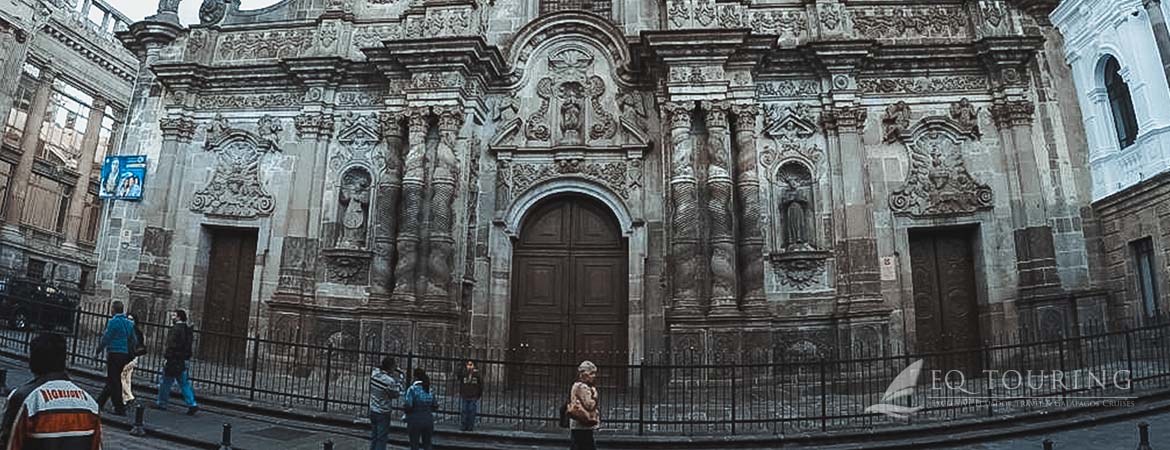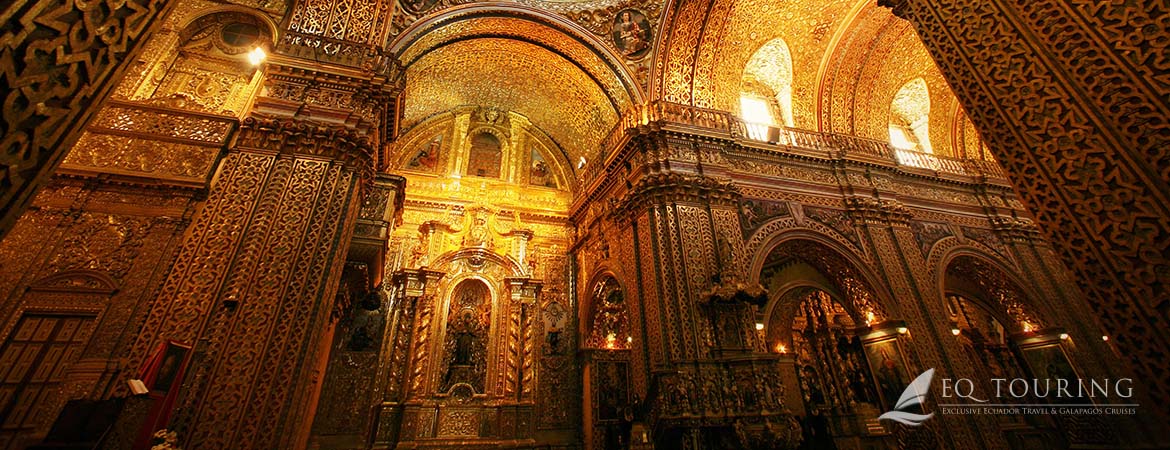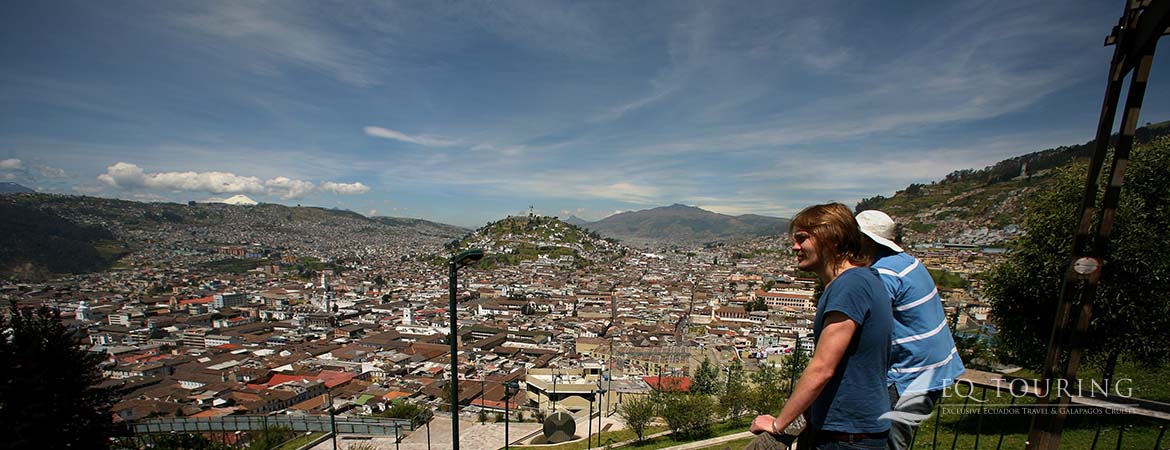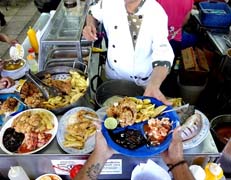Quito Full Day Tour





Quito is the second second-highest capital in the world after Bolivia’s La Paz, Quito sits at 2,850 meters (9,350 feet) above sea level in a valley hemmed in by mountains, including the twin peaks of Pichincha volcano. Quito’s dramatic geographical position has led to its long thin shape: spread out over 50 kilometers (31 miles) long, but just eight kilometers (5 miles) wide. Quito (pop. 2.8 million as of 2020) is an intriguing mix of old and new architecture: colonial squares and concrete office blocks, traditional markets and modern malls, indigenous artisans and fashion-conscious professionals and this diversity allows visitors to have the best of both worlds. The centro histórico (historic center or old colonial town) delivers a delightful trip back in time to the colonial era with narrow cobbled streets, elegant plazas, and spectacular churches as a reminder that the city was part of Europe once. New Town, on the other hand, looks firmly forward and is so cosmopolitan that parts of it are nicknamed gringolandia. With a vibrant cultural scene, great nightlife, a vast array of hotels, travel agencies, and the country’s best arrange of restaurants, it’s no surprise that Ecuador’s political capital is also its tourism hub. Much of the population of Ecuador’s second-largest city lives in barrios (neighborhoods), either up the slopes of the mountains or spread north and south of the city center. The people themselves are historically more conservative than in the rest of Ecuador; the capital has always clung to traditional, conservative values, in contrast to the outward-looking merchants of Guayaquil. However, a new generation, a large student population, and modern businesses have all injected a healthy dose of open-mindedness. Most importantly, visitors will find Quiteños helpful, welcoming, and justifiably proud of their city.
Quito’s residents have plenty to be proud of: In 1978, it was the first city in the world to receive World Heritage Site status from UNESCO. Although there have been problems with upkeep, in recent years a multimillion-dollar regeneration program has left the city in better shape than ever.
History
According to a pre-Inca legend, the city of Quito was founded by Quitumbe, son of the god Quitu, in honor of his father. The valley that would eventually cradle Ecuador’s capital was originally occupied by the Quitu people, who united with the Cara from the north to form the Shyris nation around AD 1300. In 1487, the Incas took over and turned the city into an important nexus of their northern empire, known as the Quitosuyo. Within 100 years the empire fell to infighting, leaving room for the newly arrived Spanish to start almost from scratch. The city of San Francisco de Quito was founded by Sebastián de Benalcázar on December 6, 1534, and named in honor of fellow conquistadors Francisco Pizarro. Benalcázar quickly set about appointing government officials, distributing land to his men, and constructing churches. Originally, Quito consisted only of the present-day section known as Old Town, bounded by the Plaza de San Blas to the north, the Pichinchas to the west, and the Machangra river to the east. An art school was founded in 1535 and helped the city become a center of religious art during the colonial period, with its own style, the Quito school. Since its founding, Quito has been an administrative rather than a manufacturing center. A population boom in the mid 20th century, aided by the discovery of oil, brought thousands of immigrants who spread their homes and businesses into today’s New Town, as well as farther south of Old Town and west up the slopes of Pichincha. By the mid-1980’s, these makeshift suburbios housed as much as 15 percent of the city’s population and had acquired most of the services that the older areas took for granted. An earthquake in 1987 damaged numerous structures and left others in ruins, and the eruption of Guagua Pichincha in 1999 showered Quito in ash but otherwise left the city unscathed. Today, the city is officially home to about 2.8 million residents, but the real number is likely higher.
Climate
Quito is famed for its spring like climate, and most of the year daytime temperatures fluctuate 10-21C (50-75F). Mornings tend to be chilly, but it can hit up considerably around midday, and temperatures drop quickly on rainy afternoons and in the evenings. Locals say that the city can experience all four seasons in a single day, and that isn’t far off the mark. The dry season lasts June-September, with July-August seeing the least precipitation. This is also the warmest time of the year. A shortened dry season runs December-January, which is also the coldest time of the year. The most rain falls February-April and, to a lesser extent, October-November. Afternoons tend to be rainier, so sightseeing early is a good idea. More of a consideration than the weather is the elevation, which will leave you breathless and light-headed for a couple of days. Dizzy spells, headaches, and fatigue can also occur. It is best not to overexert yourself and to minimize caffeine and alcohol in favor of plenty of water and light food. After two or three days, you’ll be used to the elevation.
Orientation
Quito extends over 5;0 kilometers north-south, and about eight kilometers across. Luckily for first-time visitors, the capital is easily divided into zones: one for historical sights (Old Town); one for visitor services, restaurants, and accommodations (New Town); and then everything else. The city’s long, narrow geography makes it quite easy to get around. A new system of street numbers was implemented in Quito in 2000, with letters prefixing the normal hyphenated numbers (e.g., “Foch E4-132”). Most addresses also give the nearest cross street, so the full address would be “Foch E4-132 y Cordero.”
Old Town
Quito’s historical heart sits at the northern flank of El Panecillo (Little Bread Loaf) hill, whose statue of the Virgin is visible from most of the neighborhood. This area, also called Quito Colonial or centro histórico (historic center), is roughly bordered by 24 de Mayo to the south and Parque Alameda to the north. Most of the sights are situated within a few blocks of the central Plaza de la Independencia, the original core of the city. Steep, narrow streets characterize this part of Quito, and cars barely fit in lanes designed for horse and foot traffic. Wrought-iron balconies hang over ground-level storefronts selling household wares, clothing, and shoes. Most visitors come for the outstanding churches, convents, museums, and plazas that are key to Quito’s status as a UNESCO World Heritage Site. Other visitors are content to wanted the cobbled streets that evoke Ecuador’s colonial past. There are many wonderful viewpoints to take in Old Town’s impressive skyline—from the gothic spires of the Basílica to the top of El Panecillo or the green spaces of Parque Itchimbía.
New Town
Northeast of Old Town, Parque La Alameda and El Ejido form a buffer between past present. New Town is a world away from the colonial cobbled streets of the historic center. The Mariscal Sucre area is the hub and aptly nicknamed gringolandia for its abundance of hotels, restaurants, tour operators, shops, Internet cafés, bars, and discos. This area, enclosed by Avenidas Patria, Orellana, 10 de Agosto, and 12 de Octubre, is alive with backpackers and also doubles as the city’s main area for nightlife, heaving with parties on weekends. North and east of La Mariscal are quieter neighborhoods such as La Floresta and Gonzáles Suárez, as well as Quito’s largest park, Parque Carolina. To the east, high above this park, is one of the highlights of the city, artist Oswaldo Guayasamín’s famous work, La Capilla del Hombre (Chapel of Man).
Quito Tours

This interesting and renovated city tour starts with a visit of the Itchimbia neighborhood, which is a place that offers a spectacular view of the old and new city. Then you will visit one of the oldest streets in the town “La Ronda Street” where you will see how the colonial houses were built and how the Quiteños lived in the 17th century. Your walk takes you through the city museum to San Francisco Plaza, making a quick stop to try the typical sweets of Quito. San Francisco is the oldest church in Quito and it is full of history and legends.
Finally, you will tour the main square where the presidential palace, the main cathedral and some other important buildings can be appreciated, your Guide will take you back in time with the history and traditions that this main square preserves.
La Compañía de Jesus church is one of the most beautiful churches in South America, or perhaps, in the world. This is the last treasure to be visited on our program before your guide takes you to the equator. After a delicious Ecuadorian lunch you will visit the INTI-ÑAN museum, where you will learn about the different cultures in Ecuador and some interesting facts about the Equator.

Your guide will take you to the « Mercado Central » (a real local experience) where you stop at various affiliated stations, the Chef explains about the fresh products mostly organic and culinary our culinary traditions. You buy together the ingredients for the cooking class. You will return to Altamira restaurant (walking or by transport).
The cooking class begins: we offer you a chef's hat and an apron for preparing the 3 dishes you will cook; which they are typical Ecuadorian recipes: a « Locro Quiteño », a « Encocado » and a Chocolate Soup. These foods have been chosen specifically because the ingredients used can be found worldwide, so you will have the chance to cook these recipes in your own country. You are invited to participate and to become a Chef: you have the possibility to manipulate food, peel, cut, season, mix, beat... During the class, the Chef is accompanying and guiding you, he gives explanations and details about the history of each dish and its origin. After elaborating the 3 courses, you have the pleasure to taste what you have prepared with the Chef in a unique place; in the “patio” of a Colonial House of Quito.
Your personal private Guide will take you for a pleasant walk through the main cobble-stone streets of the old colonial city where you will see architecture that will remind you to the main cities of Spain. You can visit certain building and churches since they have been important temples in the city decorated with gold and a unique barroco style.
At the end of your afternoon you will discover the night colors and lights of the Historical Center in Quito from the top of one of the most beautiful churches in Quito: Santo Domingo. We will have the unique chance to have private access to the Domes of the Church and you’ll have a private tour of the Convent. Here you will be welcomed with a nice house red wine paired with gourmet Ecuadorian snacks. This will be a heart filling and why not romantic way to end your tour of one of the oldest cities of South America.
| Accomodations | 3 DAYS / 2 NIGHTS |
|---|---|
| Wayra room | $1,437 |
| Yaku Suite | $1,721 |
| Rates per person in US Dollarsstarting at: Double occupancy | |


